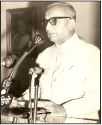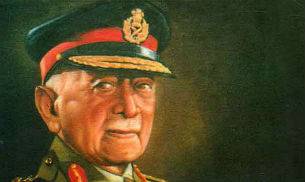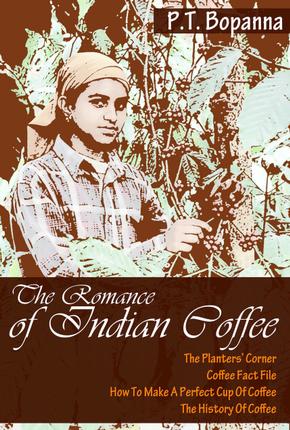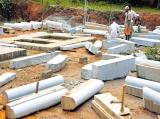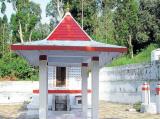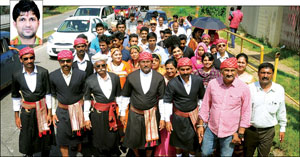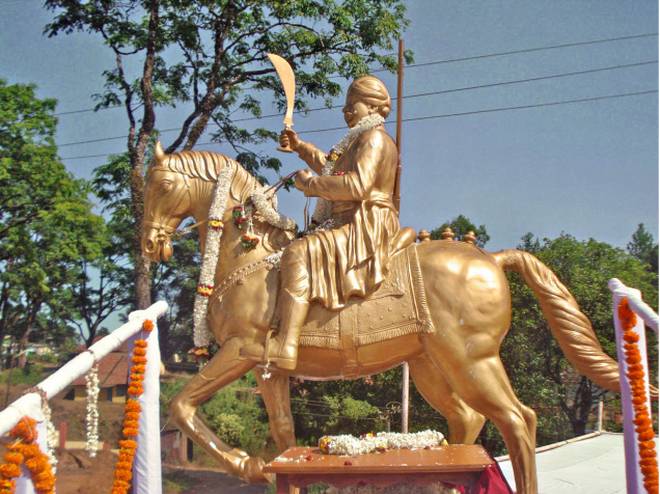Review of Kaveri Ponnapa’s book “The Vanishing Kodavas”
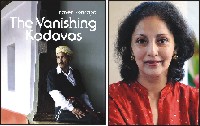
Title : The Vanishing Kodavas / Author : Kaveri Ponnapa / Pages : 360 / Price : Rs. 7,500 / Publisher: Eminence Designs Pvt. Ltd. [Order from www.thevanishingkodavas.com]
New Light on Kodavas of Kodagu – 1
People are interested in history because they want to know their roots; they want to know who they are; they want to know their progenitor. And with their physical features, colour and gait being different from their immediate neighbours, they want to know the why and how of it. The desire to know their ancestry becomes even more strong if their customs, costumes, culture, cuisine, language, songs of oral tradition and even Gods are different from those of others. The question arises if they could be of the land where they have been living from time immemorial or did they come from another part of this country or from another country traversing thousands of miles by land or sea due to historical reasons? War, pestilence or famine?
The Kodavas of Kodagu district in Karnataka belong to this class of unique people who want to know. Hence, there is an abiding interest among the successive generations of Kodavas, even scholars, to know their ancestry, history of their land of hills and valleys with thick rain forests, criss-crossing rivers and streams, having very high rainfall for over four months in a year. They are the high-landers and hardy people — physically strong and daring at any task and in war.
In retrospect, I myself being the son of that clan and soil, it can be said that these Kodavas lived on this land from the dim past to this day fighting all the time for survival with the nature and wild animals like tigers, elephants and vermins that destroyed their paddy fields and other crops; fighting the local chieftains of their own clans and the invaders from the neighbouring kingdoms till the geographical unity and political stability was attained when Kodagu (with Sulya and Puttur) became a kingdom under the Haleri Dynasty from 1600 to 1834 — 234 years.
In between, there was an interregnum when Hyder Ali and his son Tipu Sultan ruled Kodagu uneasily, under constant armed resistance from Kodava chieftains, for 11 years from 1780 to 1791 when Madikeri was renamed as Zaferabad.
In a classic example of the saying, “My enemy’s enemy is my friend,” the Kodagu Rajahs cultivated British of the East India Company, who were engaged in fighting Tipu Sultan, a sworn enemy of Kodagu Rajahs. So Tipu’s enemy, the British, became the friend of Kodagu Rajahs. But alas, in a tragic play of history, the British were able to de-throne and deport Chikkaveera Rajendra Wodeyar in 1834 after being betrayed by the Rajah’s trusted Dewans Cheppudira Ponnappa and Apparanda Bopu. Despite the Rajah’s army successfully resisting the British at the other two fronts, at the Eastern stockade it was a meek, humiliating surrender by Dewan Apparanda Bopu with a party of 400 Kodavas at the present Kushalnagar to Col. Frazer (hence Kushalnagar was known as Frazer Town).
The Dewan then “led the British troops back to Madikeri where the Union Jack was hoisted on 6th April 1834. The last battle for Kodagu was a sad betrayal,” writes Kaveri Ponnapa in her magnum opus of a book on Kodagu and Kodavas titled “The Vanishing Kodavas,” the book under review.
However, let me submit a caveat here. The records indicate the young King Chikkaveera Rajendra was more into outdoor activity, ironically with visiting Englishmen, of hunting and camping leaving the matters of State in the hands of trusted and able Kodava Dewans and also a Dewan from his own caste Kunta Basava, an evil genius no doubt, and another Muslim Dewan, probably to neutralise the power of Kodava Dewans mentioned above. When the relation between the Rajah and the East India Company got strained on the question of extradition of fugitives and the Kodava Dewans realised the end result of an inevitable war, they counselled the King to negotiate peace. But, the King was adamant. The Kodava Dewans, in the circumstances, decided that ‘discretion was better part of the valour.’ The British had already defeated a more powerful Tipu Sultan than the Kodagu King and as for weapons of war, the Britishers had cannons which the Kodagu Rajah did not have. If only Chikkaveera Rajendra had negotiated peace, he could have continued in the throne like the Mysuru dynasty under the suzerainty of the British Company.
Curiously, a large number of scholars and people, who have read the history of Kodagu written by many, are fed with information that shows the Haleri Kings, specially Doddaveera Rajah, Linga Rajah and the last Rajah, Chikkaveera Rajendra Wodeyar in poor light, as tyrants and mentally deranged towards the end of each one’s rule.
The history of Kodagu commissioned by Doddaveera Rajah in 1807 known as “Rajendranama” and another by Linga Rajah known as “Hukumnama,” the land laws of 1812, can be verified to find out its veracity and the good administration delivered by these rulers. The secret, if the word can be used, of the Haleri Rajahs ruling Kodagu for so long, 234 years, is no doubt because they never interfered with the land holdings of Kodavas, their customs, culture and, in short, Kodavas’ way of life. And Kodavas in return served their Kings loyally till the ‘betrayal,’ for self-preservation of Kodagu and Kodavas, came in 1834.
The proof of the Haleri Kings being good rulers is in the representation made to the British Government on 13th April 1834, just 7 days after the surrender, signed by 400 senior officials of Rajah’s Government, expressing their entire satisfaction with the Rajah’s rule and with grief requesting that the Rajah be allowed to remain in Kodagu.
Kaveri Ponnapa writes, “Despite the fact that he had an infant son, Prince Chitra Shekara, when he was conducted out of his kingdom, no attempt was made by the British to restore Haleri rule by placing a Regent over Kodagu, as had been done in some States, including nearby Mysore.” One would wish the author had given more information on Prince Chitra Shekara. Pray whatever happened to him? Interestingly, the Rajah begot more children in exile — in captivity at Varanasi ! To jest, what else could he have done with nothing else to do !
This book by Kaveri Ponnapa, based on 15 years of research, nearly 200 visits to Ainemanes (ancestral houses), historical locations, sacred places and interviews with elders in Kodagu, debunks many tendentious works on history and culture of Kodavas. The wealth of information, not so much on political history but on other aspects of Kodava life and culture, contained in the book The Vanishing Kodavas astonished me no end.
The book is a treasure trove of many informations hitherto presented in a distorted manner or suppressed from us to justify British occupation of Kodagu. I am reminded of a great Nigerian proverb which says that until the lions have their own historians, the history of the hunt will always glorify the hunter. Let it be.
It is, therefore, necessary for us to question the description of Chikkaveera Rajendra as a bad King in the eponymous novel by Masti Venkatesha Iyengar. No wonder there were protests and criticisms when Masti Venkatesha Iyengar was given Jnanpith Award for this book and when an attempt was made to produce a film-based on the book. ______________________________________
New light on Kodavas of Kodagu – 2
The book, The Vanishing Kodavas, however, does not answer the fundamental question: If not the natives of the land, where did the Kodavas come from? Many have ventured to address this question without any answer, leaving us in a sea of absurd speculations. One had tried to trace Kodavas’ origin to Rajasthan and parts of North India by drawing similarities between names of some clans there to the family (Okka) names of Kodavas. They also link the similarity in the distinct individual Kodava names like Muddappa, Muthappa, Machiah, Ponnappa, Somaiah, etc.
Some have speculated that a breakaway army unit of Alexander-the-Great had trekked to Kodagu from North India looking for a safe haven. Some others speculate Arab descent finding strong similarities between the Arab cultures and social life and that of Kodavas — the headgears (red-check vastra, head scarf) worn while at work and on special occasions, the ornate gold or silver dagger held by the sash (chale) tied around the waist, the white one-piece knee-length upper garment etc., complete with other artifacts.
Yet, some researchers on the origin of Kodavas opine Kodavas are Scythians, Eurasian nomads who landed in Kodagu. A 1398 Kannada dictionary says Kodavas are Mlenchas come from outside the country. Others have told us that Kodavas are Kurds, a hill-tribe of Arabia come here after a long journey by the sea, landing in Malabar coast of Kerala, then making an arduous journey to a safe hilly place inhabited sparsely by the local tribals — Kodagu. Well, if this is so, I doubt, the name Kodagu could not have been derived from the Tamil word ‘Kodimalenad’ — Hill Forest Land, an eponymous name as speculated in the book under review.
Extending this kind of speculation a bit further to Kurds, one can say the name Kodagu might have come after these Kurds (pronounced Koords) occupied this land, suggesting it is the land of Kurds which name, in its corrupt form or with minor distortion in pronunciation, must have become Kodagu the land of Kurds, Kodavas. The English called Kodava as Coorg and in early Church records it is Kurg.
To add to the confusion, of late, we have a Greek come to Kodagu making similar speculation — Mr. Antonios Vasileiadis. He says the customs of the people of Kodagu bear a striking resemblance to those of Ancient Greece. Can we connect this to the earlier speculation of Kodavas being the breakaway warriors of Alexander’s Army? 300 BC!
The book also does not address two other important questions. One, the origin of Kodava language which is a dialect and the other, the origin of the name of each okka clan or family — like Ajjikuttira, Apparanda, Biddanda, Chowrira, Kambiranda, Nadikeriyanda etc. And so far, no one has answered these enigmatic questions including that of our origin. I guess these questions will remain riddles wrapped in mystery inside an enigma even as Kodavas may vanish in the next 100 or so years from their ancient land Kodagu, perhaps, leaving behind their land, language, okka names, personal names, traditional dress, customs etc., in short, the treasure chest of their hoary past. Thereafter, they can be seen or heard only in the digital library or in books like “The Vanishing Kodavas.” Which is why, this book is a wonderful Collector’s Item, specially for Kodavas.
Is the title of the book prophetic? Time alone can say! UNESCO has already sounded the warning saying Kodava language is among the disappearing languages of the world. If so the people who speak the language may also disappear lost in a diaspora. And even as one reflects on the dismal future of this unique race under the sun, one will wonder how was it that these Kodavas whose number is 2.3 lakh (with 1.5 lakh living in Kodagu) survived for centuries as an ethnic people, practising a distinctive life found nowhere else in India or in the world. In a sense, it is providential that Kodavas survived so long in Kodagu in the absence of a religious or temporal head from their own blood-line to hold the flock together and bind them under a singular culture common to all Kodavas.
The book bears the stamp of not only the scholarship of the author, the love of labour of a patriotic Kodavathi but also the tremendous research and leg-work that have gone into its making. It has between its 360 pages, 12 chapters devoted to specific subjects, 300 colour and sepia photographs of superb quality and of archival value, most helpful guide to a reader of this kind of a researched book. The glossary of Kodava words is exhaustive and descriptive to leave no doubt in the mind of a serious reader about the import of those Kodava words and names; the select bibliography authenticates what is researched and will help those who wish to write on Kodavas and Kodagu in future.
Kaveri Ponnapa is beholden to so many who co-operated and helped her in writing this book. A grateful author recognises each one of them and also okkas acknowledging their help — proof of her deep sense of gratitude. I am sure in the next edition some more names will appear should she learn there are omissions! Index to a book of this kind can never be understated but here it is done with such meticulous care one is left wondering at the hard work by the team that put the book through production. Photo credits too are there which is as it should be.
I must mention here the depth and sweep of her work of extraordinary research with just one example. It is about least of an item used by Kodavas to deserve a research. It is about a ceremonial walking stick, made of black wood, known as gejje thand, a waist high staff. Her research finds out that it is made from the male kari mara (botanical name Diospyros ebenum) decorated with strips of beaten silver and tiny bells. She writes in detail about its significance and power as spirit medium and more. I guess Kaveri Ponnapa does not seem to have left a single stone unturned in her research that concerned Kodava life and culture.
At one point she mentions of the precepts delivered by an elder at the time of solemnising the marriage. Readers would wish a sample text of it was published. May be the next edition will find a place for it.
_________________________________________
New light on Kodavas of Kodagu – 3
For those Kodavas, who have been opposing the Jamma tenure of land holding in Kodagu, an act which is self-defeating in the context of the need to keep their land for themselves and thereby their identity as a unique people, here is some food for thought from the book:
“Since time immemorial the ownership of land has been the foundation of Kodava identity, and the thakkas and Haleri Rajahs, in their wisdom, made the Jamma lands inalienable, with reason.”
Lewis Rice, writing in 1878, summed it up best, his words proving to be prophetic in today’s Kodagu: Hence the Coorgs who hold lands on Jamma tenure are prohibited from alienating them, a restriction which was in force in the time of Rajahs, and which is absolutely necessary in order to prevent all the land in the province from gradually falling under the ownership of settlers from the low country. And should the ownership of the soil, which rightly belongs to them as a nation, pass away from the Coorgs… the independence and self-respect of a fine race will be sacrificed…
No wonder Britishers did not interfere with the land holdings in Kodagu. British did not also interfere with the law prohibiting slaughter of cattle and sale of beef that existed during the rule of Haleri Rajahs in Kodagu. I am one of the irrelevant majority of Jamma holding Kodavas, Gowdas, Mapillahs and others in Kodagu who agree with Rice and his warning.
The beginning of the end of Kodagu and Kodavas was when Kodavas felt betrayed by their elected leaders. The book says, Cheppudira M. Poonacha, the then Chief Minister of Kodagu, a Kodava himself, went down in Kodava history as the man responsible for the merger of Kodagu with Karnataka in 1956.
The fate of Kodagu and Kodavas was hermetically sealed by this unholy, sinister merger once and for all accelerating the ‘vanishing’ of Kodavas and Kodagu. According to Kaveri Ponnapa, this political move of merger “cost them (Kodavas) their independence, wrested the control of their land from their hands, severely depleted the natural resources and eroded the Kodava identity.”
Now, after Kodava political leaders gave away Kodagu on a platter to Karnataka for their own selfish political ambitions, the Kodavas and Jamma land owners became victims of the new Land Revenue Act of Karnataka that is often used to keep them under constant threat of eviction from their land — Jamma, Bane, Paisari. Kodagu’s development suffered under Karnataka. The Revenue Department practically rubbished the land records under all pervasive corruption and favouritism. The roads were neglected. For example, Hunsur-Gonikoppa road had remained unmotorable for six years. Many private bus operators stopped service and car owners avoided this road. The high-tension power-line was drawn across Kodagu forests, paddy fields and coffee estates despite objections and agitations. There are more trees in coffee estates today than in the forests. The latest threat to their land holding comes from the UNESCO plan to declare major parts of Kodagu as Eco-Sensitive Zone and the controversial Dr. Kasturi Rangan report that will adversely impact 55 villages. That probably will be the last nail to the Kodagu coffin.
A feeble effort is being made to overcome these dangers by Codava National Council (CNC), led by Nandineravanda Uthappa Nachappa demanding creation of a Kodava Autonomous Region, but there seems to be little hope as Kodavas are divided among themselves.
Now, before I vanish from these columns, a few words about the author Kaveri Ponnapa whom I had the privilege of meeting along with her husband Kambeeranda Naresh Ponnapa, a big-time software industrialist in Bengaluru, at their house of unique architecture in Whitefield. There was very little about her in the book which says that she studied English Literature at Lady Shri Ram College, Delhi and took a Master’s Degree in Social Anthropology in London. Like nature, she wants to remain half-revealed. Let us respect her sentiment but let me reveal that she is the daughter of Lt. Gen. B.C. Nanda, now settled in Kodagu.
The book is too heavy to handle. It is more like a Coffee-Table Book in its style of page layout. The font size needs to be increased. Such small type is harsh on eyes. It is best to have this book in two volumes with photographs compatible only to the text, not to please individuals who might have assisted the author. The next edition needs to take these changes, nay the challenge, seriously to make it reader-friendly. Should the expensive art paper be of that thickness merely adding to the weight of the book?
And finally, my most sincere thanks to Kaveri Ponnapa for giving us this pictorial book which will preserve for posterity the religious, social practices and agricultural activities, with keepsake photographs of Kodavas who are likely to join the ranks of Lost Tribes of the world.
e-mail: kbg@starofmysore.com
source : http://www.starofmysore.com / Star of Mysore / Home> Abracadabra…..Abracadabra / by K.B.Ganapathy / September 26th, 2015
